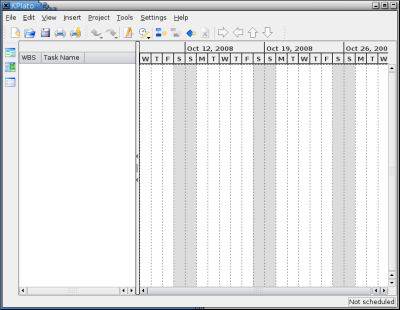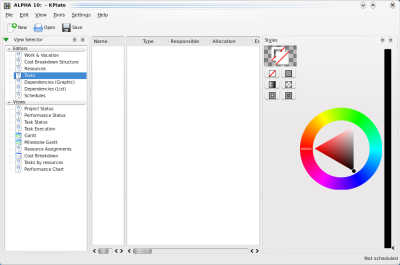Author: Bruce Byfield
Yesterday, I looked at the major applications in the first beta for KOffice 2.0. Now it’s the turn of the rest of the beta: The KPlato project manager, KChart, the vector graphics editor Karbon, and the raster graphics editor Krita.
These four graphical and charting programs have always been among the best-regarded of the KOffice programs. All of them have matured much faster than the traditional office applications KWord, KSpread, and KPresenter.
In the case of KPlato and KChart, they have done so because they were limited applications with relatively few features. By contrast, the graphics editors Karbon and Krita have done so by attracting users who were not interested in office applications so much as design.
All four of KOffice’s graphical and charting programs have changed far less in version 2.0 than the traditional office suite applications. They simply had less need to change.
Aside from the addition of a feature here or there in these programs, the main difference in the 2.0 beta is the new common interface, with its collection of floating palettes called Dockers. Dockers work extremely well with graphics programs, and in fact probably originated in Karbon and Krita, both of which have used floating palettes for some time.
The KPlato project manager
Earlier versions of KPlato have always seemed faintly intimidating, opening on a blank chart that users need to fill. The new version presents a more user-friendly face, with the options for editing different aspects of a project (such as tasks, resources, and dependencies) and different views (such as Gantt chart and Performance status) listed in a Docker on the left side of the window. With these tools directly in front of you, getting started in KPlato is now far easier.
The drawback is that this additional information leaves little room for displaying the chart views themselves. Fortunately, though, you can drag the left-hand Docker out of the editing window or dock it on the top edge to give yourself more room for the view.
KChart
While you can run KChart as a separate program, more properly it is a subsystem you call from another application, such as KSpread. Since it has very specific functionality, it reached maturity several versions ago. Unsurprisingly then, KChart in the version 2.0 beta has changed little — at least so far as one can tell when most of the items in the Format menu have still to be implemented.
The biggest change in the beta is the default presence of Dockers. Many of the default Dockers seem overkill for a program with such limited functionality, and those that do not seem a mixed blessing. On the one hand, the Styles Docker makes it easy to change the background of a chart with a couple of mouse clicks. But, on the other hand, Dockers like the ones for Shape and Shadows make it far too easy for users to add what information expert Edward Tufte refers to as “chart junk” — flashy extras that look impressive in a presentation, but add nothing to the value of the information. In this case, the new uniform interface risks encouraging bad work habits.
The Karbon14 and Krita graphics editors
Karbon and Krita are probably the most mature of KOffice applications, so it is unsurprising that they have changed the least in the new beta. Both have a Docker for layers that other programs have no need of, but, otherwise, the main difference in appearance is that, in the beta, the Dockers are arranged in a single pane instead of two.
Otherwise, you would be hard-pressed to find major changes in the latest versions of KOffice’s graphic editors. The biggest are probably the introduction of paths (arbitrary shapes with no predefined structures) in Karbon and masks (areas protected or made invisible to certain operations) in Krita, together with new menus of basic commands for them. However, these are important additions, because, in each case, they fill major gaps in functionality. With these new features, Karbon becomes more or less the functional equivalent of Inkscape, while Krita comes close to the GIMP in everything except the number of available filters.
Conclusions
Judging a final release from its beta is always chancy. However, while the hard work that has gone into KOffice 2.0 is obvious, I suspect that the end result may disappoint some users.
Admittedly, it is a pleasure to see some of the last pieces of functionality in Karbon and Krita slipping into place. But, after the months of development, some of us were hoping that the rest of KOffice, like KDE 4.1, would stop playing catchup and start to innovate more. While some signs of innovation do exist in the design of tools, for the most part, they are few and generally slight.
KOffice is an ambitious project. In the last release or two, it completed the transition to using OpenDocument Format as its native format, and has begun cross-platform development for Windows and Mac OS X. In the long run, these efforts may pay off in popularity, but such fundamental changes seem to have come at the expense of features in some of the most basic apps.
While the final release may bring surprises, the current signs are that KOffice 2.0 will be an uneven collection of apps, with some outstanding in their fields and other basic ones still lagging behind equivalent programs. And, if that is so, then the worse thing will be knowing that we probably have to wait another two to four years before KOffice becomes all that it should be.
Categories:
- Reviews
- Office Software
- Graphics & Multimedia




